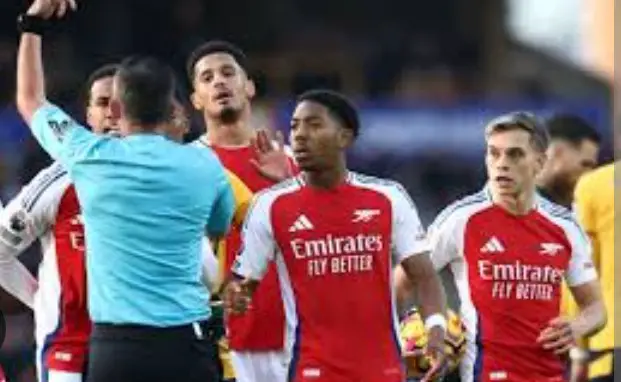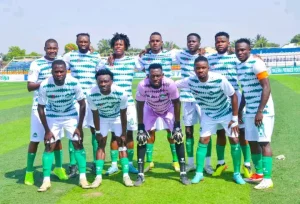
The Premier League has revealed the justification for Myles Lewis-Skelly’s controversial red card for Arsenal against Wolverhampton Wanderers, Euro Sport reports.
The Arsenal defender was given a straight red card on 43 minutes, but the circumstances drew plenty of criticism from fans and observers given the harsh interpretation of the rules.
Arsenal had a corner, which Wolves were able to quickly clear. Matt Doherty picked the ball up close to his own side’s penalty area and looked to launch a counter-attack through the middle of the pitch, as Mikel Arteta’s men tried to race back to protect their own goal.
Arsenal are one of several clubs who have led the way in the use of tactical fouls, where players risk incurring a yellow card with cynical trips or tugs to prevent nascent attacks from their opponents.
It seemed that Lewis-Skelly was attempting such a move when he clipped the heels of Doherty, sending him to the ground.
Even Arsenal players would have been left unsurprised to see their 18-year-old defender receiving a yellow card as a result, but instead, referee Michael Oliver was quick to brandish a straight red card.
With the use of VAR prevalent in Premier League games, many would have expected Oliver to be invited to check his decision once again with video assistance, but there was no such invitation, with the system backing the referee’s on-pitch decision.
During half-time, the Premier League issued an explanation for the decision on their ‘Match Centre’ X account, stating: “The referee’s call of a red card for Lewis-Skelly was checked and confirmed by VAR, who deemed his challenge to have been serious foul play.”
The red card may be appealed by Arsenal if they believe there has been a wrongful decision.
Despite playing much of the second half with a numerical disadvantage, Arsenal earned a valuable 1-0 win thanks to Riccardo Calafiori’s strike, shortly after Joao Gomes had also seen red for Wolves.
Got what it Takes?
Predict and Win Millions Now
Got what it Takes?
Predict and Win Millions Now
Tijdens de wedstrijd tussen Leeds United en Wolverhampton Wanderers in de Engelse Premier League (EPL) op 7 november 2021, ontstond er controverse rondom de rode kaart die aan Leeds-speler Pascal Struijk werd gegeven na een tackle op Wolves-speler Raúl Jiménez. De beslissing van scheidsrechter Anthony Taylor om Struijk van het veld te sturen heeft tot veel discussie geleid onder fans, spelers en experts.
De rode kaart werd uitgereikt nadat Struijk een tackle had ingezet op Jiménez, waarbij de Mexicaanse spits geblesseerd raakte en het veld moest verlaten. De scheidsrechter beoordeelde de tackle als gevaarlijk spel en besloot Struijk te bestraffen met een rode kaart. Dit besluit leidde tot verontwaardiging bij Leeds United-manager Marcelo Bielsa en de fans van de club, die vonden dat de rode kaart te zwaar was.
De reden achter de controversiële rode kaart van Struijk ligt in de interpretatie van de regels omtrent gevaarlijk spel in het voetbal. Volgens de regels van de FIFA wordt een tackle als gevaarlijk beschouwd wanneer een speler zijn tegenstander in gevaar brengt door onvoorzichtig of roekeloos gedrag. In dit geval oordeelde scheidsrechter Taylor dat Struijk te laat was met zijn tackle en daardoor het risico op letsel bij Jiménez vergrootte.
De beslissing van scheidsrechter Taylor om Struijk een rode kaart te geven, is gebaseerd op de interpretatie van de regels en de situatie op het veld op dat moment. Hoewel sommigen het eens zijn met de beslissing, zijn er ook veel mensen die vinden dat de rode kaart te streng was en dat Struijk niet met opzet Jiménez wilde blesseren.
Het incident heeft geleid tot discussies over de regels omtrent gevaarlijk spel in het voetbal en hoe scheidsrechters dergelijke situaties moeten beoordelen. Het is belangrijk voor spelers om zich bewust te zijn van de regels en consequenties van hun acties om blessures en controversiële beslissingen te voorkomen.
Al met al laat de rode kaart voor Struijk tijdens de wedstrijd tussen Leeds United en Wolverhampton Wanderers zien hoe subjectief beslissingen in het voetbal kunnen zijn en hoe belangrijk het is om de regels en interpretaties ervan te begrijpen om controverses te voorkomen.

